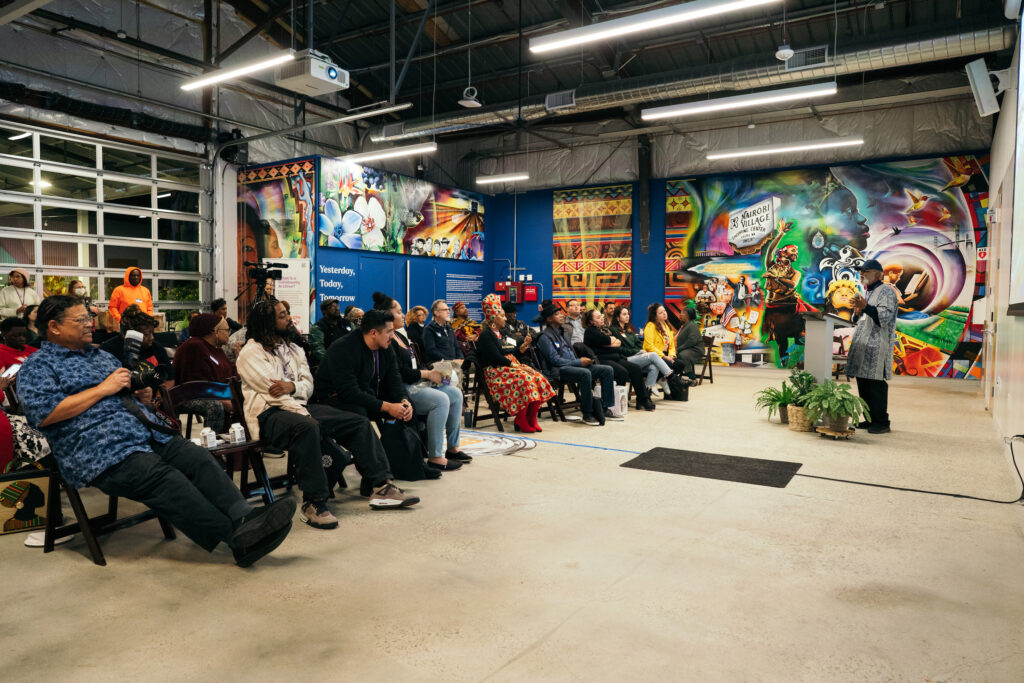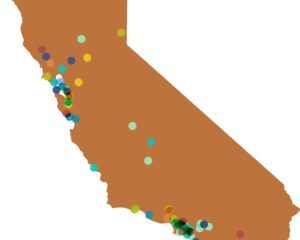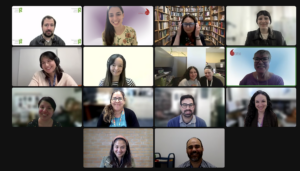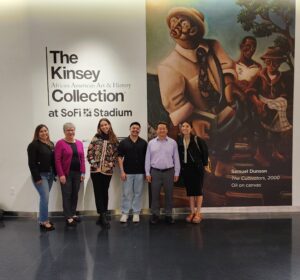Above: East Palo Alto Community Archive’s celebration on December 1, 2023 recognizing community individuals who participated in their online visual storytelling series. Courtesy of Sharifa Wilson.
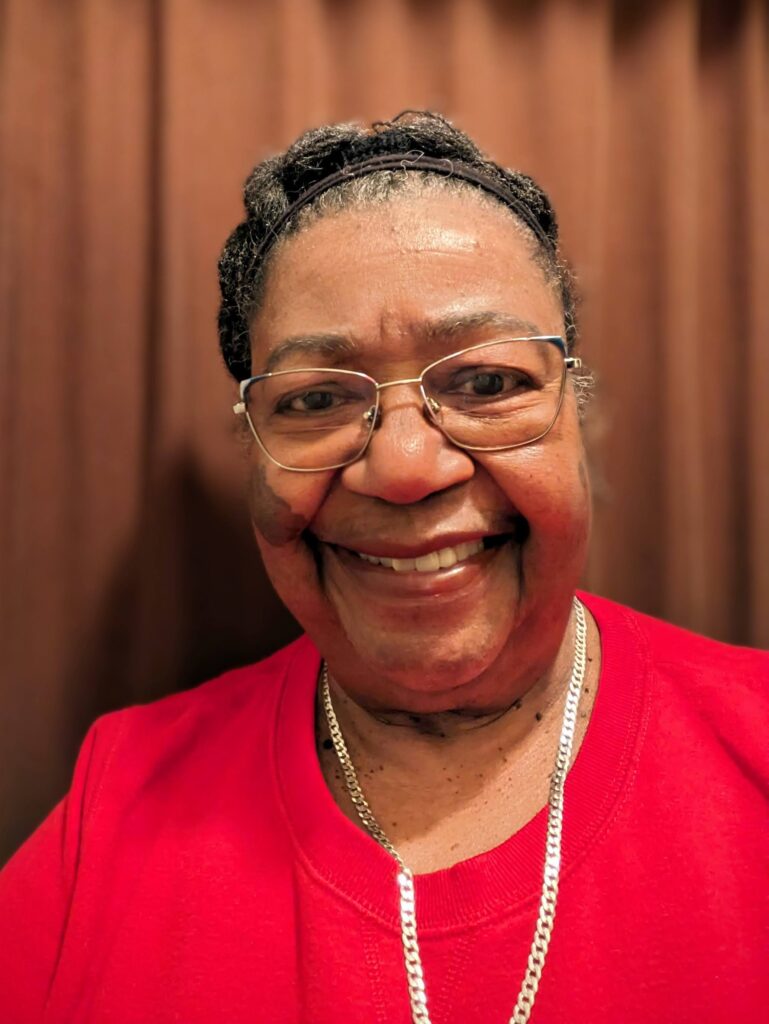
In celebration of Women’s History Month, we spoke to community activist Sharifa Wilson, Executive Director of the East Palo Alto Community Archive and director of its Oral History Project. The recipient of a fall 2023 California Humanities’ Humanities for All Project Grant, this project continues the Archive’s efforts to build a collection of stories that represents the community’s diverse cultures and histories, including the perspectives of members of the city’s Latinx, Black, and Pacific Islander communities.
Wilson, currently a non-profit consultant focusing on program development, advocacy, and community change, is well positioned to lead this effort. She began her career working with children in East Palo Alto and as a teacher in the Ravenswood district, before being elected to the East Palo Alto City Council, where she served for 12 years. For three of these years, Wilson was Mayor, and for five as Vice Mayor and Chair of the Redevelopment Agency. In addition to serving on the city’s Ravenswood City School District Board of Trustees, Human Services Commission, Personnel Commission, and Rent Stabilization Task Force, she has worked with nonprofit youth serving organizations, such as College Track, One EPA, and Live In Peace and serves on the board of the EPA Family YMCA & EPA Tee-Ball/Pitching Machine.
In a few words, tell us about your connection to East Palo Alto (EPA) – did you grow up in the community? If not, what brought you to it?
After graduating from New York University, I gifted myself a trip to California. During that trip, I spent time in both Southern and Northern California. I loved the San Francisco Bay Area. Some years later, when I decided to leave New York, I moved to Northern California and to East Palo Alto.
You have had a distinguished career serving EPA, first as a teacher and then as a city council member and Mayor, among several positions in city politics. What led you to make that transition, and what have you learned, from both arenas, about serving the community?
Working as a teacher in the community, I became familiar with the children and the families. I became engaged in the community because of that. I consider myself a “children’s advocate” and when I looked at the conditions for the children in the community, it made me want to help to make it better.
The city had recently incorporated (July 1, 1983), and it provided an opportunity for residents to participate. I began by volunteering to serve on a commission, which led me to run for City Council. After serving on the city council for 12 years, I went on to serve on the Ravenswood School Board for 12 years. I firmly believe that each of us can do something to make our communities better than when we inherited it.

What I’ve learned from the experience of serving community is to be open to seeing things from the other person’s perspective. You must be respectful and tolerant and “not take it personally.” It is a tremendous responsibility to work on behalf of the community, one that needs to be taken seriously and where you prioritize what the community needs and desires.
Are there any women leaders or trailblazers that have been special sources of inspiration for you?
I am proud to say that my mother has inspired me over the years. She modeled community engagement, serving in various leadership positions in my schools and in the projects where I grew up. My mother organized the community to have a new school constructed to replace the building built in the 1800s. Two years later, I was in the first class to graduate from the auditorium of that new school.
My other inspiration was Barbara Mouton, the city’s first Mayor. She was a devoted community advocate and a strong woman who stood her ground. She was courageous and determined, a fearless leader who inspired me to serve on the city council.

In 2021, the East Palo Alto Community History Archive (EPACHA) launched the Oral History Project in order to create a platform where community residents could share their stories in their own words. Can you say more about its creation and upcoming activities?
During community-wide information meetings hosted by several developers throughout 2020, residents raised several issues, among them the issue of “losing our history.” Residents have a lot of anxiety about proposed changes to the community. East Palo Alto is one of the only cities where local control is in the hands of people of color, but we realize things will change in the future. We believe East Palo Alto serves as an example of self-determination and self-empowerment.
One of the city’s founders who helped lead the fight for incorporation—Dr. Omowale Satterwhite—was recruited to lead an effort to develop an archive. He approached me and I gladly joined the effort.
We are striving to build a robust digital and physical archive about the people, places, events, and traditions that shaped East Palo Alto. Our collections are organized under three main themes: historical periods, social sectors, and demography. Our vision is that the archive collections will cover the history of East Palo Alto from the Ohlone Nation Era to the present.
Since our launch, EPACA has already collected about 90 oral stories from community members, with more stories added throughout the year that help capture the diversity found within East Palo Alto. Our organization will continuously add these stories to our website, building out the digital archive. We also aim to connect with approximately 800 to 1000 people through our events, where people can learn about the Oral History Project. In 2025, we will host an Oral History Showcase that will provide an opportunity for the public to engage with the project.

How can the humanities promote civic engagement and active citizenship?
Humanities as a tool promotes civic engagement by giving space for people to come together to share experiences and learn from one another. Humanities encourages our curiosity and ability to connect across differences and supports more effective empathetic social change. Creating opportunities for the preservation of history can also be a goal of the humanities. Allowing us to learn from our past teaches us that change is possible because we have already made so much change. Civic engagement will result in an active citizenship. When people are given safe spaces to interact and speak their truth, they can use that experience as they become more civically engaged.
“Allowing us to learn from our past teaches us that change is possible because we have already made so much change.”
Sharifa Wilson
What is your vision for the future of EPA? Of California?
My vision for the future of East Palo Alto is that it will always be a place where diversity and inclusion are respected and encouraged. A place where all individuals feel safe and have the opportunity to live and thrive. A place that supports different groups: races, religions, abilities, genders, and economic status. A place where all individuals have equal opportunities and are not held back by discrimination or prejudice. This is also my vision for California.
Visit the East Palo Alto Community Archive’s website.
Watch and listen to the stories that the Oral History Project have captured so far.

